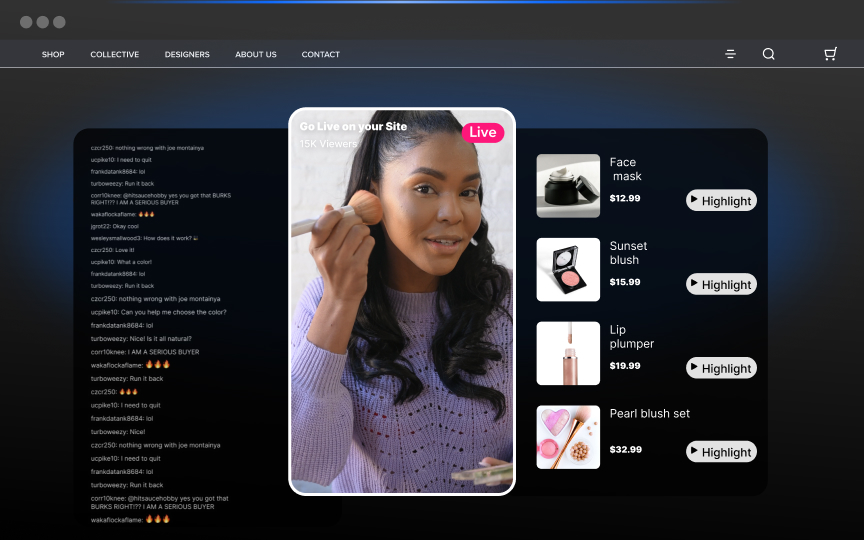You’ve probably noticed that social media isn’t just for sharing memes and catching up with friends anymore. It’s become a powerful tool for businesses to reach and engage with customers.If you’re in marketing, you might be wondering how to make the most of this trend. Social commerce could be the answer you’re looking for.Let’s break down what social commerce is and how it can benefit your marketing strategy.
What is Social Commerce?
Social commerce is the integration of social media and e-commerce. It allows users to discover, research, and purchase products directly through social media platforms. This seamless experience makes it easier for customers to buy products without leaving their favorite apps. By combining the social aspect of these platforms with the convenience of online shopping, social commerce creates a more engaging and efficient shopping experience.Wondering how to implement social commerce effectively? Let's dive into some key strategies that can elevate your marketing game. For more insights, check out these social commerce strategies.
Key Social Commerce Strategies for 2024
Leverage User-Generated Content
Encouraging customers to share their experiences with your products can significantly boost your brand's credibility. User-generated content (UGC) acts as social proof, showing potential buyers that real people enjoy and endorse your products. You can prompt customers to share photos, videos, or reviews by running contests or offering incentives. Reposting this content on your social media channels not only builds trust but also fosters a sense of community around your brand. Learn more about building community with video.
Implement Shoppable Posts
Transforming your social media posts into shoppable content can streamline the purchasing process for your customers. By tagging products directly in your posts, you make it easy for users to click and buy without leaving the app. This reduces friction in the buying journey and can lead to higher conversion rates. Platforms like Instagram and Facebook offer features that allow you to tag products in photos and videos, making every post a potential sales opportunity. Explore the future of shoppable videos.
Collaborate with Influencers
Partnering with influencers can help you reach new audiences and build credibility. Influencers have established trust with their followers, and their endorsements can carry significant weight. Choose influencers whose audience aligns with your target market. Collaborations can range from simple product mentions to more involved campaigns like takeovers or exclusive product launches. Leveraging influencers' reach and credibility can drive both awareness and sales. Discover how shoppable videos for DTC can elevate your influencer collaborations.
Utilize Social Media Advertising
Creating targeted ads on social media platforms allows you to reach your ideal customers more effectively. Use the advanced targeting options available to hone in on demographics, interests, and behaviors that match your customer profile. Craft compelling ad content that resonates with your audience and encourages them to take action. Regularly analyze and optimize your ad campaigns to improve ROI, adjusting your strategy based on performance data. Check out these customer engagement strategies for more tips.
Provide Exceptional Customer Service
Using social media as a customer service channel can enhance your brand's reputation and customer satisfaction. Respond promptly to inquiries, comments, and complaints to show that you value your customers' feedback and are committed to resolving their issues. This level of responsiveness can turn potential negative experiences into positive ones, fostering loyalty and encouraging repeat business. Demonstrating excellent customer service on social media also allows other users to see your dedication to customer care.Feeling the pressure to boost your brand's visibility and conversion rates? Social commerce might be your game-changer.
Benefits of Social Commerce for Marketing Teams
Increased Brand Awareness
Social commerce significantly boosts your brand's reach and visibility. When you integrate your products into social media platforms, you tap into a vast audience that spends a considerable amount of time scrolling through their feeds. Each post, story, or video featuring your product serves as a touchpoint with potential customers. The more engaging your content, the more likely it is to be shared, liked, and commented on, extending your brand's presence far beyond your immediate followers. This organic spread can introduce your brand to new audiences who might not have discovered you through traditional marketing channels.
Higher Conversion Rates
A simplified purchasing process directly impacts conversion rates. Social commerce allows customers to buy products without leaving their favorite social media apps. This seamless experience reduces the steps and friction involved in the buying process. When customers see a product they like, they can click on it, view details, and make a purchase within the same platform. This convenience encourages impulse buys and reduces the chances of cart abandonment, leading to higher conversion rates. The ease of use and immediate gratification can turn casual browsers into paying customers more effectively. Discover more video commerce benefits.
Valuable Customer Insights
Social media interactions provide a wealth of insights into customer preferences and behaviors. Every like, comment, share, and purchase offers data that can be analyzed to understand what your audience likes and dislikes. These insights help you tailor your marketing strategies to better meet customer needs. For example, if a particular product post receives a high level of engagement, you know that item is popular and can focus more marketing efforts on it. Additionally, feedback in comments and direct messages can reveal common questions or concerns, guiding product development and customer service improvements.
Cost-Effective Marketing
Social commerce can be more cost-effective than traditional marketing channels. Creating and sharing content on social media often requires less budget compared to producing TV commercials or print ads. Social media platforms also offer targeted advertising options that allow you to reach specific demographics, ensuring your marketing budget is spent more efficiently. The ability to track and measure the performance of your social commerce efforts in real-time helps you optimize your campaigns for better ROI. This cost-effectiveness makes social commerce an attractive option for marketing teams looking to maximize their impact without overspending.Curious about the mechanics of social commerce and how it fits into your marketing strategy?
How Does Social Commerce Work?
Social commerce integrates social media and e-commerce platforms seamlessly. This integration allows users to discover, research, and purchase products directly within their favorite social media apps. Here's how it works:Customers come across products through various touchpoints on social media. These include posts, ads, and influencer collaborations. For instance, a user might see a product in a friend's post, a targeted ad, or an influencer's story. Each of these touchpoints serves as a gateway to the product, making it easy for users to engage with the brand.Once interested, customers can explore product details without leaving the social media platform. They can view images, read descriptions, and even watch videos showcasing the product. This immediate access to information helps in making quick purchase decisions.The purchasing process is straightforward. Social media platforms have built-in features that allow users to add products to their cart and check out directly. This eliminates the need to navigate to an external website, reducing friction and making the buying process more efficient.In summary, social commerce leverages the power of social media to create a seamless shopping experience. Customers discover products through engaging content and can complete their purchases without ever leaving the app. This integration not only simplifies the buying journey but also enhances customer engagement and satisfaction.Concerned about staying ahead in the ever-evolving world of social commerce? Here are some trends to keep an eye on.
Social Commerce Trends to Watch in 2024
Increased Adoption of Shoppable Livestreams
Shoppable livestreams are gaining traction as a dynamic way to engage customers. These live events allow you to showcase products in real-time, answer questions, and interact with viewers. The immediacy and interactivity of livestreams create a sense of urgency, encouraging viewers to make purchases on the spot. Expect to see more brands hosting live shopping events on platforms like Instagram, Facebook, and emerging players. This trend leverages the power of real-time engagement to drive sales and build a community around your brand. For a comprehensive guide, check out this shoppable video guide.
Growth of Social Commerce on Emerging Platforms like TikTok
TikTok continues to rise as a significant player in the social commerce space. Its short-form video content is perfect for showcasing products in a fun and engaging way. With features like TikTok Shopping, you can integrate product links directly into videos, making it easy for users to purchase what they see. The platform's algorithm-driven content discovery means your products can reach a vast and diverse audience. As TikTok's user base grows, so does its potential as a powerful tool for social commerce. Learn about video commerce innovations that can help you stay ahead.
Personalization of Social Commerce Experiences Using AI and Machine Learning
AI and machine learning are transforming how you can personalize the shopping experience. These technologies analyze user behavior and preferences to deliver tailored product recommendations and personalized content. For example, AI can suggest products based on a user's browsing history or past purchases, increasing the likelihood of conversion. Machine learning algorithms can also optimize ad targeting, ensuring your promotions reach the most relevant audience. Personalization enhances customer satisfaction and boosts sales by making the shopping experience more relevant and engaging.
Expansion of Social Commerce Beyond B2C to B2B
Social commerce is no longer limited to consumer markets. B2B companies are starting to see the value in leveraging social media for sales. Platforms like LinkedIn are becoming more commerce-friendly, allowing businesses to showcase products and services, generate leads, and close deals directly through social channels. B2B social commerce involves creating content that addresses the specific needs of business clients, such as detailed product demonstrations, case studies, and industry insights. This trend opens new avenues for B2B marketers to reach decision-makers and streamline the purchasing process.Wondering how to measure the effectiveness of your social commerce efforts? Here are some tips.
How to Measure the Success of Your Social Commerce Strategies
Track Key Performance Indicators (KPIs)
To gauge the effectiveness of your social commerce strategies, start by monitoring key performance indicators (KPIs). Engagement rate, click-through rate (CTR), and conversion rate are crucial metrics to keep an eye on.
- Engagement Rate: This metric shows how actively users interact with your content. High engagement indicates that your posts resonate well with your audience. Track likes, comments, shares, and saves to understand what type of content drives the most interaction.
- Click-Through Rate (CTR): CTR measures the percentage of users who click on your social commerce links compared to the total number of users who view the post. A high CTR suggests that your content is compelling and encourages users to take action. Monitor this metric to identify which posts or ads generate the most interest.
- Conversion Rate: This metric tracks the percentage of users who complete a purchase after clicking through your social commerce links. A high conversion rate indicates that your social commerce strategy effectively turns interest into sales. Regularly review this metric to identify successful tactics and areas needing improvement.
Analyze Customer Feedback
Customer feedback provides valuable insights into your social commerce performance. Collect feedback through comments, direct messages, and reviews on your social media platforms.
- Gather Feedback: Encourage customers to share their thoughts about your products and shopping experience. Use surveys, polls, and direct interactions to gather detailed feedback. Pay attention to recurring themes or issues mentioned by multiple customers.
- Analyze Feedback: Review the collected feedback to identify common pain points and areas for improvement. Positive feedback highlights what you're doing right, while negative feedback reveals opportunities for enhancement. Use this information to refine your social commerce strategies and address customer concerns promptly.
Conduct A/B Testing
A/B testing helps you optimize your social commerce strategies by comparing different versions of your content to see which performs better.
- Test Variations: Create two or more versions of a social commerce post, ad, or strategy element. Change only one variable at a time, such as the call-to-action, image, or headline, to isolate the impact of each change. Run these variations simultaneously to ensure a fair comparison.
- Measure Results: Track the performance of each variation using your KPIs. Determine which version generates higher engagement, CTR, or conversion rates. Analyze the data to understand why one version outperformed the other.
- Optimize Performance: Use the insights gained from A/B testing to refine your social commerce strategies. Implement the winning elements across your campaigns to improve overall performance. Continuously test new variations to stay ahead of changing trends and preferences.
By focusing on these methods, you can effectively measure and enhance the success of your social commerce strategies. For a comprehensive guide on creating effective content, check out this video content strategy.Curious about best practices to ensure your social commerce efforts align with your overall marketing goals?
Best Practices for Implementing Social Commerce
Aligning your social commerce strategies with your overall marketing goals ensures a cohesive approach. Start by identifying your primary marketing objectives, whether it's increasing brand awareness, driving sales, or enhancing customer engagement. Integrate these goals into your social commerce plans. For instance, if your goal is to boost sales, focus on creating shoppable posts and targeted ads that lead directly to product pages. Consistency between your social commerce efforts and broader marketing strategies will help you achieve a unified brand message.Ensuring a seamless and user-friendly shopping experience is key to retaining customers. Simplify the purchasing process by reducing the number of steps required to complete a transaction. Use features like shoppable posts and in-app checkout options to make it easy for users to buy products without leaving the social media platform. Optimize your product pages for mobile devices, as most social media users access platforms via their smartphones. A smooth, hassle-free shopping experience encourages repeat purchases and positive word-of-mouth. For more tips, explore these video marketing tips.Maintaining brand consistency across all social media platforms builds trust and recognition. Use the same logos, color schemes, and tone of voice in your posts, ads, and interactions. Consistent branding helps customers easily identify your content, regardless of the platform. Develop a style guide that outlines your brand’s visual and verbal identity, and ensure all team members adhere to it. Consistency not only reinforces your brand identity but also enhances the overall customer experience.Regularly engaging with your audience and responding to their feedback fosters a strong community around your brand. Monitor your social media channels for comments, messages, and mentions. Respond promptly to questions, thank users for positive feedback, and address any concerns or complaints. Engaging with your audience shows that you value their input and are committed to improving their experience. Use feedback to make informed decisions about product improvements, content creation, and customer service practices. Regular interaction with your audience can lead to increased loyalty and advocacy. For more insights, check out this guide on video content creation.Still on the fence about whether to invest in social commerce? Here's why it could be a game-changer for your marketing strategy.
Is Social Commerce Worth Investing In?
Social commerce is a rapidly growing trend that is expected to continue in 2024 and beyond. As more consumers spend time on social media, integrating shopping experiences directly within these platforms becomes increasingly relevant. This trend isn't just a passing phase; it's reshaping the way people discover and purchase products. By adopting social commerce, you align your business with current consumer behaviors, ensuring you remain relevant in a competitive market.Investing in social commerce can help you stay competitive and meet changing customer expectations. Today's consumers expect seamless, convenient shopping experiences. They want to discover products, read reviews, and make purchases without leaving their favorite social media apps. By offering this streamlined experience, you not only meet these expectations but also enhance customer satisfaction and loyalty. Staying ahead of the curve with social commerce ensures you don't lose customers to competitors who are quicker to adapt.The benefits of social commerce, such as increased brand awareness and higher conversion rates, make it a worthwhile investment for marketing teams. Social media platforms offer extensive reach, allowing you to connect with a broader audience. When users engage with your shoppable posts, share user-generated content, or participate in live shopping events, your brand visibility increases. This organic exposure can lead to higher engagement and more followers, expanding your potential customer base.Higher conversion rates are another significant advantage. Social commerce simplifies the purchasing process, reducing the steps needed to complete a transaction. When customers can buy directly from a social media post or ad, the convenience encourages impulse purchases and reduces cart abandonment. This streamlined process translates to more sales and better overall performance for your marketing efforts.Put your commerce in motion. Find out how Firework can power your business forward.As social commerce continues to evolve, leveraging the right tools and strategies becomes crucial for staying ahead. Firework offers a comprehensive video commerce and engagement platform designed to transform your digital storefront. From shoppable videos to interactive livestreams, our solutions enhance customer experiences and drive higher conversion rates. With our advanced features like AI-driven chat and social simulcasting, you can create a seamless, personalized shopping journey that meets modern consumer expectations.Ready to elevate your social commerce strategy? Request a demo today and discover how Firework can revolutionize your online presence.
Unlock Exclusive Insights
By submitting this form, you agree to Firework's privacy policy and consent to receive personalized marketing communications. You can unsubscribe at any time.




























